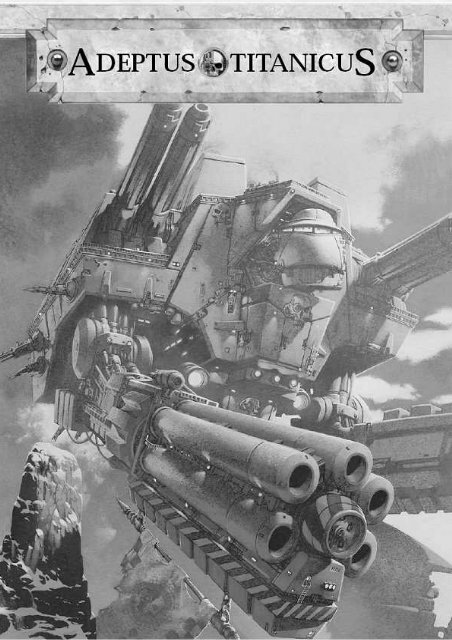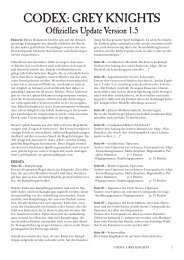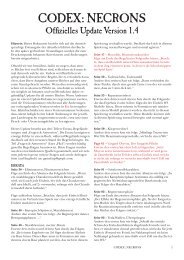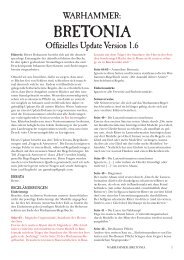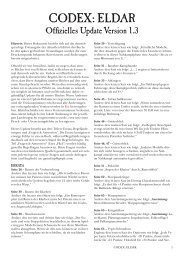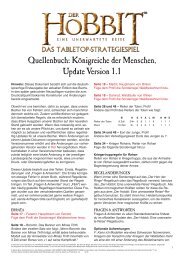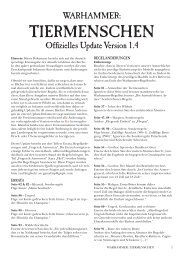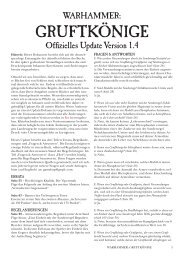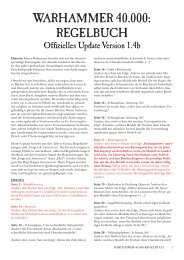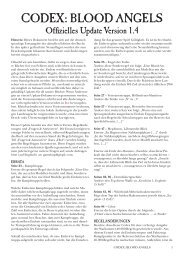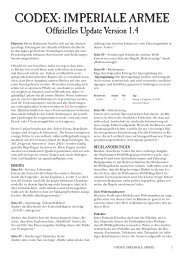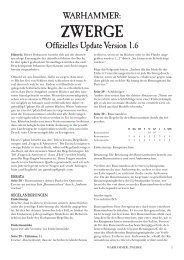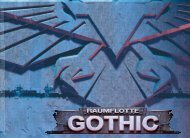Adeptus Titanicus core rules version 1 - Games Workshop
Adeptus Titanicus core rules version 1 - Games Workshop
Adeptus Titanicus core rules version 1 - Games Workshop
Create successful ePaper yourself
Turn your PDF publications into a flip-book with our unique Google optimized e-Paper software.
INTRODUCTION<br />
For ten thousand years the Imperium has warred<br />
on its enemies. War is the universal state of man;<br />
peace is only a brief time of preparation for<br />
further fighting. Alien races strike at the<br />
Imperium’s frontier systems. Rebellion and<br />
treachery are commonplace on thousands of<br />
colonised worlds. The Traitor Legions, confined<br />
for millennia in the desolate Eye Of Terror, chafe<br />
and probe at the Imperium. And in the eddies and<br />
storms of warp space, forces and creatures of<br />
darkness are stirring. The wars have no end, for<br />
that would be the end of Man. In its perils<br />
Mankind has one guide: the Emperor. In his care<br />
rests the fate of humanity. At his right and left<br />
hands are the weapon and shield of Mankind, the<br />
forces of the Imperium – the mighty Titans of the<br />
<strong>Adeptus</strong> <strong>Titanicus</strong>.<br />
Titans are the supreme fighting machines of the<br />
Imperium. They are giants with skins of<br />
adamantium, protected by fields of almost<br />
impenetrable energy, crewed by devoted warriors<br />
and armed with the mightiest weapons Imperial<br />
tech-priests can devise. Through the Imperium<br />
and beyond nothing inspires the same kind of<br />
awe and fear.<br />
Using the <strong>rules</strong> below you can re-create some of<br />
the greatest Titan battles of Imperial history.<br />
Read the <strong>rules</strong> through carefully, and then have a<br />
practice game just using one Titan per side. After<br />
playing a couple games like this you will be ready<br />
to expand your force and field a Titan battle<br />
group on each side.<br />
THE RULE OF ONE AND SIX<br />
Any dice roll which s<strong>core</strong>s a natural 1 always fails,<br />
regardless of modifiers.<br />
Any dice roll which s<strong>core</strong>s a natural 6 always<br />
succeeds, regardless of modifiers.<br />
TITAN CHARACTERISTICS<br />
There are two aspects to a Titan – the Titan itself,<br />
and its weapons. Each Titan has some basic<br />
characteristics which show how fast,<br />
manoeuvrable and durable it is. Combined<br />
together, the characteristics are called the Titan's<br />
profile. The characteristics on a Titan's profile are:<br />
SPEED (SP)<br />
This shows how fast the Titan can move over<br />
open ground. Speed is given in centimetres, and<br />
ranges from 10cm for very large, ponderous<br />
Titans to 30cm or more for small agile Scout Titans.<br />
MANOEUVRE (MAN)<br />
This shows how quickly the Titan can change<br />
direction, and react to certain situations. The<br />
Manoeuvre characteristic shows how many turns<br />
a Titan can make during its movement, and is also<br />
used in some other situations, such as avoiding<br />
difficult terrain.<br />
ARMOUR (ARM) AND DAMAGE TABLES<br />
Each Titan has three Damage Tables, one for the<br />
Front, one for the Side and another for the Rear.<br />
These are used to determine what damage is<br />
suffered when the Titan is hit by a weapon. The<br />
higher a Titan's Armour value, the better able it is<br />
to withstand attack.<br />
WEAPONS<br />
A Titan has a number of hardpoints which can<br />
carry a weapon. This shows where the weapons are<br />
mounted and therefore what their 'fire arc' is (see<br />
below).<br />
GUNNERY (GUN)<br />
This is a representation of how accurate the<br />
Titan's crews are at shooting with their weapons,<br />
written as the s<strong>core</strong> you need to equal or beat on<br />
a roll of a D6 to s<strong>core</strong> a hit. For example, a Titan<br />
with a Gunnery s<strong>core</strong> of 4+ will hit its target with<br />
its guns on a D6 roll of 4, 5 or 6.<br />
CLOSE COMBAT SKILL (CCS)<br />
This shows how skilled the Titan crew is when<br />
fighting other Titans, trying to batter one another<br />
with their close combat weapons. CCS is given as<br />
a s<strong>core</strong> you need to equal or beat on a roll of a D6<br />
to s<strong>core</strong> a hit.
TITAN GUNS<br />
The galaxy of the 41st millennium has evolved<br />
many different and deadly weapons, from rapid firing<br />
cannon that hurl a torrent of shells, to<br />
sophisticated laser weapons that punch through<br />
armour like a knife through butter, to plasma<br />
weapons that unleash barely controlled energies.<br />
Like the Titan itself, a weapon's effectiveness is<br />
determined by a number of different<br />
characteristics which make up its profile:<br />
RANGE (RGE)<br />
The distance, in centimetres, that a weapon can<br />
fire and still hit its target with reasonable accuracy<br />
or with sufficient force to cause damage.<br />
Obviously, the higher a weapon's Range, the<br />
better.<br />
ACCURACY (ACC)<br />
Some guns are inherently more or less accurate to<br />
fire, and the Accuracy value modifies the Titan's<br />
Gunnery value when firing that weapon. A<br />
positive Accuracy (e.g. +2) is good, while a<br />
weapon with a negative accuracy (e.g. -1) is not as<br />
easy to hit with. Most weapons have a '-' which<br />
means they do not modify the Titan's Gunnery.<br />
RATE OF FIRE (ROF)<br />
Some guns fire only a single shot while others<br />
hurl a salvo of fire at the enemy. The Rate of Fire<br />
of a weapon determines how many shots you get<br />
with it every time it fires.<br />
STRENGTH (STR)<br />
This shows how powerful the weapon is, and<br />
therefore how likely it is to inflict damage if it hits.<br />
The higher a weapon's Strength, the more likely it<br />
is to punch through a target's armour.<br />
TITAN CLOSE<br />
COMBAT WEAPONS<br />
While massive lasers and barrages of missiles can<br />
pound an enemy from a distance, many Titan<br />
battles are resolved in the vicious conflict of close<br />
combat. Huge powered fists, laser-burners and<br />
swinging wrecking balls can cause horrendous<br />
damage to an enemy Titan.<br />
7<br />
Like guns, close combat weapons also have a<br />
profile of characteristics.<br />
ACCURACY (ACC)<br />
Close combat weapons vary in their effectiveness.<br />
Some are deft and agile to use, while others are<br />
cumbersome and unwieldy. A close combat<br />
weapon's accuracy modifies the CCS of the Titan<br />
using it. A positive Accuracy (e.g. +2) is good,<br />
while a weapon with a negative accuracy (e.g. -1)<br />
is not as easy to hit with. Most weapons have a '-'<br />
which means they do not modify the Titan's Close<br />
Combat Skill.<br />
ATTACKS (ATT)<br />
Like a gun's Rate of Fire, a close combat weapon<br />
might inflict one blow or hit several times. The<br />
higher a close combat weapon's number of<br />
attacks, the more times it can strike in close<br />
combat.<br />
STRENGTH (STR)<br />
This shows how powerful the weapon is, and<br />
therefore how likely it is to inflict damage if it hits.<br />
The higher a weapon's Strength, the more likely it<br />
is to punch through a target's armour.<br />
SEQUENCE OF PLAY<br />
<strong>Adeptus</strong> <strong>Titanicus</strong> III uses the following turn<br />
sequence:<br />
1. Determine Initiative.<br />
2. Choose a Titan to Activate.<br />
3. Roll Plasma Reactor dice.<br />
4. Declare Actions in order.<br />
5. Resolve Actions in order.<br />
6. Opposing player chooses a Titan to Activate,<br />
and repeats steps 2 – 6.<br />
Once all the Titans on the board have been<br />
Activated, begin a new game turn starting at step 1.<br />
INITIATIVE<br />
Both players roll one die. The player with the higher<br />
s<strong>core</strong> may choose a Titan to activate. Re-roll ties.
CHOOSE A TITAN TO ACTIVATE<br />
Titans may be Activated in any order. However, each<br />
Titan may only be Activated once per game turn.<br />
ROLL PLASMA REACTOR DICE<br />
Titans have Plasma Reactor rating marked on their<br />
Profile. This represents the amount of power the<br />
Titan can generate to fire weapons, move, repair void<br />
shields, etc. When each Titan is activated roll a<br />
number of D6 equal to its Plasma Reactor rating. For<br />
each roll of 4+ the Titan can take one Action.<br />
Example: A Warlord Titan has a Plasma Reactor<br />
rating of 5. The player rolls 5D6, and three of them<br />
come up 4+. The Warlord can take three Actions this<br />
turn.<br />
ACTIONS<br />
For each successful Plasma Reactor dice roll the<br />
Titan can take one Action. The player must declare<br />
all actions in the correct order before resolving any of<br />
them.<br />
• Walking Speed – The Titan may move up to<br />
its full speed rating and make a number of<br />
turns equal to its Manoeuvre rating.<br />
• Striding Speed – Only taken after a Walking<br />
Speed Action. The Titan may again move up<br />
to its full speed rating and make a number of<br />
turns equal to its Manoeuvre rating.<br />
• Fire – Pick a weapon and fire it a number of<br />
times up to its ROF. You must nominate the<br />
weapon and the target when declaring this<br />
Action. No weapon may be fired more than<br />
once per turn. The target must be within<br />
Range and Fire Arc of the weapon.<br />
• Lay a weapon onto an enemy Titans’ Hit<br />
Location – Nominate a weapon to aim at a<br />
specific Hit Location on an enemy Titan. Next<br />
time the weapon fires any shots that hit do<br />
not roll on the Hit Location chart. Instead<br />
they automatically hit the location aimed at.<br />
The target location must be visible, so you<br />
cannot aim at a Warlord’s Void Shield<br />
Generators from the front, as they are not<br />
visible. Example: “Lay Volcano Cannon onto<br />
enemy Plasma Reactor!”<br />
• Power to Damage Control Systems – Roll<br />
as many D6 as the Titan’s Plasma Reactor<br />
rating or a D6 for all damaged locations,<br />
whichever is less. On a 4+, the damaged<br />
location is repaired. The boxes crossed off<br />
on the Titan’s profile chart stayed crossed<br />
off, but effects of damage may be repaired.<br />
Example: A Reaver class Titan has suffered<br />
Superficial damage to the Legs, which<br />
results in a -5cm movement penalty.<br />
Declaring a Power to<br />
Damage Control Systems order, the player<br />
rolls a die and s<strong>core</strong>s a 5. the Superficial Leg<br />
damage is repaired, and the movement<br />
penalty no longer applies. However, the<br />
Superficial box remains crossed off, and<br />
further hits will result in Major damage.<br />
• Power to Void Shield Generators – Roll as<br />
many D6 as the Titan’s Plasma Reactor<br />
rating or a D6 for each downed Void Shield,<br />
whichever is less. Each roll of 4+ raises one<br />
downed Void Shield.<br />
Example: Following on from the example<br />
above,<br />
the Warlord Titan has three Actions. The<br />
player decides that it will first “Fire Gatling<br />
Blaster!” at an enemy Titan which he names.<br />
It will then move at Walking Speed, and<br />
finally direct “Power to Void Shield<br />
Generators.” These Actions are now resolved<br />
in the order declared.<br />
MOVEMENT<br />
When a player declares a Walking Speed or Striding<br />
Speed action they may move their Titans around the<br />
battlefield, as determined by their Speed and<br />
Manoeuvre.<br />
MOVING<br />
A Titan can move up to its Speed in centimetres.<br />
At any point during its movement a Titan can<br />
make one turn up to 45° for each point of<br />
Manoeuvre it has. If a Titan has a Man of 2 or<br />
more, these turns can be combined into a single<br />
turn of up to 90° or more, so that it could turn on<br />
the spot, for example, before moving off.
DANGEROUS TERRAIN<br />
Some types of terrain are called ‘dangerous’ – a<br />
Titan moving through them will be considerably<br />
slowed down. If a Titan starts its movement in<br />
dangerous terrain or enters dangerous terrain as<br />
part of its move, then roll 1D6 per point of Man<br />
the Titan has. The total s<strong>core</strong> is the distance the<br />
Titan can move through the dangerous terrain.<br />
If a Titan starts in open terrain and moves into<br />
dangerous terrain, roll a D6 for each point of Man<br />
it has not spent that phase. This is the total<br />
distance it can move through the dangerous<br />
terrain, though it cannot move further than its<br />
total Speed, even if the dice roll would allow this.<br />
Similarly, if you roll enough for a Titan to leave<br />
the dangerous terrain then the distance rolled is<br />
taken off its Speed, and any movement left after<br />
this may be taken as normal movement. If there is<br />
in sufficient Speed left after this deduction to<br />
move any further, the Titan stops moving just<br />
outside the dangerous terrain.<br />
If a Titan moves from one type of dangerous<br />
terrain to another type (from rubble into a river,<br />
for example), there is no need to roll separately<br />
for each type of terrain – you just have to roll for<br />
moving through any kind of dangerous terrain.<br />
If a Titan wishes to turn whilst in dangerous<br />
terrain, it must give up a point of Man for each<br />
turn it will make, and not roll a D6 for it when<br />
determining the distance travelled.<br />
EXAMPLE 1<br />
An Eldar Revenant Scout Titan (Man 4) is moving<br />
through a wood. It wishes to make a single turn<br />
and so only rolls 3D6 for its total Speed for the<br />
turn. The dice s<strong>core</strong> 11 so the Titan can move up<br />
to 11cm through the wood, making a single turn<br />
up to 45°.<br />
EXAMPLE 2<br />
A Reaver Titan (Man 2 and Speed 20cm) moves<br />
10cm before entering a wood. The player uses<br />
both remaining points of Man to negotiate the<br />
dangerous terrain and rolls 2D6, luckily scoring<br />
an 11. However, the Titan may only move up to<br />
10cm, as this was the amount of Speed left before<br />
entering the dangerous terrain.<br />
EXAMPLE 3<br />
A Warhound Titan (Man 3 and Speed 25cm),<br />
starts in an area of rubble. It uses 2 points of<br />
Man to move through the rubble, rolling an 8.<br />
After moving 5cm it is in the open, so can move<br />
up to 17cm more, making one turn if it wishes.<br />
Note that the Warhound deducts the amount<br />
rolled for the dangerous terrain movement<br />
(8cm) rather than amount actually moved<br />
(5cm).<br />
The following are all types of dangerous<br />
terrain:<br />
Woods, jungle, rubble, rivers, rocks and scree,<br />
lakes, swamps, marshes, tar pits, boiling mud,<br />
crevasses, ash or sand dunes, ice, snow drifts,<br />
blizzards, dust/sandstorms, craters, high magnetic<br />
fields, acid clouds, crossing a pipeline, stepping<br />
over low fortifications, very steep inclines (going<br />
down as well as up is difficult) and so on…<br />
For terrain not covered by this list, just use your<br />
common sense and have both players agree before<br />
the game begins what is and isn’t dangerous terrain.
IMPASSABLE TERRAIN<br />
There are some types of terrain a Titan simply<br />
cannot enter. A Titan cannot move through<br />
impassable terrain under any circumstances, the<br />
Titan stops moving before it enters the terrain.<br />
The following are all types of impassable<br />
terrain:<br />
Cliffs, deep lakes, lava flows, buildings.<br />
Again, there will be numerous other impassable<br />
items on your gaming table. Decide for yourselves<br />
which terrain features are impassable.<br />
MOVING BACKWARDS<br />
A Titan may move backwards during its turn. Each<br />
cm of backwards movement reduces the Titan's<br />
remaining movement by 3cm. A Titan cannot<br />
move backwards in dangerous terrain.<br />
SHOOTING<br />
When a player declares a Firing Action with one of<br />
his Titans use the following <strong>rules</strong> to resolve the<br />
action. Titans which are in close combat with other<br />
Titans cannot fire ranged weapons.<br />
TITANS SHOOTING AT TITANS<br />
Each ranged weapon on a Titan can be fired for each<br />
Firing Action declared. All targets must be within fire<br />
arc and line of fire (see below). Different weapons<br />
can be, and often will have to be, directed against<br />
different targets. Note, however, that weapons<br />
with a RoF of 2 or more must still direct all their<br />
shots at a single target, they cannot split their fire.<br />
FIRE ARCS<br />
Each weapon mount on a Titan determines the<br />
direction a weapon can be pointed. Obviously, a<br />
weapon on one side of a Titan cannot swivel<br />
around to shoot over the opposite side, for<br />
example. This is called a weapon's 'fire arc' and<br />
only enemy Titans within the weapon's fire arc<br />
can be targeted. There are several different fire<br />
arcs as listed below and all fire arcs are worked<br />
out from the centre of the Titan model:<br />
ALL ROUND (AR)<br />
The weapon has a 360° fire arc.<br />
AHEAD (A)<br />
The weapon can fire in a 90° arc in front of the<br />
Titan.<br />
FORWARD (F)<br />
The weapon can be fired in a 180° arc to the front<br />
of the Titan<br />
LEFT/ RIGHT AHEAD (LA/RA)<br />
The weapon can fire in a 90° arc from straight<br />
ahead to a right angle to the appropriate side.<br />
LEFT/ RIGHT FULL (LF/RF)<br />
The weapon can fire in 180° arc from straight<br />
ahead to directly behind.<br />
REAR (R)<br />
The weapon can fire in a 90° arc directly behind<br />
the Titan.<br />
REAR FULL (RF)<br />
The weapon can fire in a 180° arc to the rear of<br />
the Titan.<br />
LINE OF SIGHT<br />
As well as being able to physically turn towards a<br />
target, a weapon must be able to see it! This is<br />
called having a 'line of sight'. If a Titan does not<br />
have a line of sight (LOS) to an enemy, then it<br />
cannot fire at it! Line of sight is fairly simple to<br />
work out – draw an imaginary line from the<br />
weapon mount to the target. If there's anything<br />
blocking this line, then the target cannot be seen!<br />
Most of the time it will be obvious if a target can<br />
be seen, though sometimes it'll be necessary to<br />
get down and have a 'model's eye' view to see if it
has a line of sight. If you can see only a small part<br />
of the enemy, such as the tip of a flag pole or<br />
weapon, or a foot poking around a building, then<br />
this isn't really enough for a line of sight. If you<br />
can see up to about half of the target then this has<br />
line of sight, but the target will be harder to hit<br />
(see Cover below) and if you can see more than<br />
half of the target then you've got a clear shot.<br />
NOMINATE TARGETS<br />
Once you have established that the enemy is in<br />
line of sight and fire arc for your Titan's weapon,<br />
continue to resolve the Firing Action by checking<br />
range.<br />
CHECK RANGE<br />
To hit its target, a weapon must obviously be in<br />
range. Measure the distance from the firing Titan<br />
to the target. If the target Titan is within the Range of<br />
the weapon then the target may be hit, if the target is<br />
further away than the weapon's Range then the shot<br />
automatically misses.<br />
ROLL TO HIT<br />
For each point of Rate of Fire the weapon has, roll<br />
1D6. Each dice roll that s<strong>core</strong>s equal to or more<br />
than the Gunnery value of the Titan has hit the<br />
target. However, the dice roll you need to get may<br />
be changed by the following factors:<br />
STATIONARY FIRER<br />
If the firing Titan has not yet moved or declared a<br />
Moving or Striding speed Action this turn, add<br />
+1 to rolls to hit.<br />
COVER<br />
If at least half the target is out of line of sight,<br />
subtract 1 from your rolls to hit.<br />
AGILE TARGET<br />
If the target has a Man of 3 or more, deduct 1<br />
from all to hit rolls.<br />
WEAPON ACCURACY<br />
Add or subtract the weapon's Accuracy from each<br />
dice roll.<br />
EXAMPLE<br />
A Titan with a Gunnery value of 4+ is firing its<br />
Gatling Blaster at an enemy Titan. A Gatling<br />
Blaster has RoF 4 and so the player rolls 4 dice,<br />
scoring a 3, 4, 5 and another 5. A Gatling Blaster<br />
has no accuracy modifier, but the target is<br />
behind a building and so counts as in cover. This<br />
deducts 1 from each of the to hit rolls, so that<br />
they count as 2, 3 and two 4's. This means that<br />
two of the shots have hit the target.<br />
RESOLVING DAMAGE<br />
When a Titan is hit, you must determine where<br />
the shot or blow has landed. For each hit, roll a<br />
D6 and compare it to the appropriate hit location<br />
table, depending on where the shot originated<br />
from.<br />
This gives the location hit and it's Armour value.<br />
Roll a D6 and add the weapon's strength to the<br />
roll. Deduct the location's armour value and look<br />
up the result on the chart below.<br />
DAMAGE TABLE<br />
D6+Str-Arm Result<br />
-1 or less No damage.<br />
0 Armour cracked. This result causes no<br />
immediate damage.<br />
However, if the location<br />
is already suffering<br />
Armour Cracked<br />
damage, then it now<br />
has superficial damage.<br />
1 Superficial damage. Refer to the damage<br />
table. If the location is<br />
already suffering<br />
superficial damage,<br />
then it now has major<br />
damage.<br />
2 Major damage. Refer to the damage<br />
table. If the location is<br />
already suffering major<br />
damage, then this<br />
becomes catastrophic.<br />
3 Catastrophic Refer to the damage<br />
-----damage. table. Apply the results<br />
of the damage<br />
immediately.
CLOSE COMBAT<br />
Titans which are in contact with each other may fight<br />
in close combat. This is accomplished by using a Fire<br />
Action, but the weapon used is a close combat<br />
weapon rather than a ranged weapon. The two<br />
combatants attempt to smash and crush each other<br />
or use specialised close combat weapons to tear,<br />
batter and cut at the armour of the enemy. Make no<br />
mistake, close combat between Titans is a brutal<br />
affair!<br />
CLOSE COMBAT ATTACKS<br />
For each Attack a close combat weapon has, the<br />
player can make one to hit roll. As with ranged<br />
weapons, a Titan may only use a close combat<br />
weapon is the target is within its fire arc. Like<br />
shooting, simply roll one dice for each attack, any<br />
that s<strong>core</strong> equal to or over the Close Combat Skill<br />
of the Titan s<strong>core</strong> a hit. The accuracy of the<br />
weapon modifies the dice roll, as with shooting,<br />
making it more or less likely to hit it's target. In<br />
addition the other modifiers apply – so if the target<br />
has Manoeuvre of 3 or more there is a -1 to hit<br />
penalty, for example.<br />
Damage is also resolved as with shooting hits,<br />
with D6+ the weapon's Strength reduced by the<br />
Titan's Armour value. Close combat attacks are<br />
not made high or low – there is no modifier to the<br />
D6 roll for location. Note that Void shields or Power<br />
fields have no effect in close combat, all damage is<br />
worked out directly against the Titan itself.<br />
IMPROVISED ATTACKS<br />
All Titans have a number of secondary weapons<br />
which blast away at short range, and many simply<br />
try to use their size to bash the enemy to the<br />
ground. If the Titan does not have a Close Combat<br />
weapon, or the weapon is not usable due to Fire Arc<br />
restrictions or damage, then the Titan may make a<br />
single Improvised attack instead. Improvised attacks<br />
have no Accuracy modifier and have a Strength of 5.<br />
They require a Fire action to activate, in the same<br />
manner as a Close Combat Weapon.<br />
FORMATIONS<br />
On occasion, Titan forces are accompanied by non-<br />
Titan units, such as the Super-heavy Tanks of the<br />
Imperial Guard. These may operate singly, in which<br />
case they function exactly as a Titan would, or they<br />
may form units known as Formations, which follow<br />
the additional <strong>rules</strong> below.<br />
A Formation consists of two or more non-Titan units.<br />
They count as a single Activation for game purposes.<br />
Once Activated, total up the number of Plasma<br />
Reactor dice of each unit, then roll all together. The<br />
number of successful rolls may then be distributed in<br />
any amounts desired throughout the Formation.<br />
Example: 3 Shadowsword Super-heavy Tanks are<br />
grouped as a single Formation. They are Activated,<br />
and each has 2 Plasma Reactor dice, for a total of 6.<br />
All the dice are rolled, and come up 2, 3, 3, 4, 4, and<br />
6, for a total of three Actions. One of the<br />
Shadowswords uses one of the Actions to repair<br />
itself with a Power to Damage Control Systems<br />
order. Another Lays its Volcano cannon onto an<br />
enemy Warlord Titan’s head, and Fires. The final<br />
Shadowsword does nothing, as all the Plasma<br />
Reactor rolls have been used.<br />
All the units in a Formation must remain within 15cm<br />
of another unit at all times. If any units are forced out<br />
of Formation, perhaps due to one unit being<br />
destroyed, then the next Actions taken must be used<br />
to return to Formation cohesion.<br />
When attacking a Formation, you may split shots as<br />
you see fit. Simply allocate a number of shots to<br />
which ever unit(s) you wish to target before rolling to<br />
hit. The usual Line of Sight and Fire Arc <strong>rules</strong> apply.<br />
Example: Having survived the incoming Volcano<br />
cannon shot, the Warlord returns fire with a Vulcan<br />
MegaBolter. Only two units of the Shadowsword<br />
Formation are visible, and one is already damaged.<br />
The Warlord allocates 3 of the MegaBolter shots to<br />
the damaged Shadowsword, and the remaining five<br />
to the undamaged unit. The Warlord’s player then<br />
rolls to hit.<br />
ADVANCED RULES<br />
The following <strong>rules</strong> are optional, and can be used<br />
by players to add extra detail and tactics to their<br />
games. You do not have to use all of the advanced<br />
<strong>rules</strong>, you can use some and not others if you<br />
wish.<br />
MERGING VOID SHIELDS<br />
Titans with void shields can protect each other my<br />
merging their shields together. This is a popular<br />
way of helping badly damaged comrades it the<br />
middle of a firefight. To merge shields, the two<br />
Titans must be in base-to-base contact with each<br />
other. Simply add the number of remaining void<br />
shields each Titan has together to see how many<br />
void shields are protecting them. If all the void<br />
shields are knocked down then the Titans can be
targeted individually as normal.<br />
SHOOTING INTO CLOSE COMBAT<br />
Normally shooting into close combat is not<br />
allowed. However, some reckless commanders<br />
have been desperate enough to try this tactic to<br />
help an outmatched ally. Titans in close combat<br />
count as having their shields merged as above. If<br />
you wish to shoot into a close combat, roll to hit<br />
as normal. However, for each hit s<strong>core</strong>d,<br />
randomise which of the combatants is hit (i.e. two<br />
Titans fighting, 1-3 is the enemy Titan, 4-6 the<br />
friendly Titan) then resolve damage as normal!<br />
POINT BLANK FIRING<br />
Shooting at enemies at extreme close range calls<br />
for a cool head and confidence more than real<br />
accuracy. If a Titan is firing at a target within<br />
15cm, use the Titan's CCS to resolve the to hit roll<br />
needed, rather than it Gunnery value. The<br />
weapon's accuracy and other modifiers apply as<br />
normal.<br />
OVERLOADING VOID SHIELDS<br />
It is possible for a Titan's princeps to direct more<br />
power to the void shield generators to sustain<br />
them against a determined attack. While this can<br />
greatly increase the Titan's chances of survival, the<br />
Princeps also risks burning the VSGs out<br />
completely. Whenever a void shield is knocked<br />
down you may choose to overload it. Roll a dice.<br />
On a roll of a 3 or more the void shield remains<br />
operational, on a roll of a 1 or 2 all of the Titan's<br />
VSGs are blown for the rest of the battle, just as if<br />
they had suffered catastrophic damage.<br />
OVERWATCH<br />
A Titan can go onto overwatch to wait for an<br />
enemy to present itself, directing all power to the<br />
weapons so that they can fire at a moment's<br />
notice. At the end of any turn a Titan can go onto<br />
overwatch for the next turn. During the next turn<br />
the Titan cannot use any Actions except Fire actions,<br />
but can fire during any part of the game turn,<br />
regardless of which Titan is currently active. You can<br />
even interrupt your opponent’s turn to fire. This<br />
means that the Titan<br />
could target an enemy as it moves from cover to<br />
cover, or wait until after close combat to see if<br />
there is an available target. However, you cannot<br />
interrupt your opponent once they have started<br />
rolling dice to resolve an action – for example if<br />
your enemy has made successful to hit rolls for a<br />
Titan you cannot try and destroy it before damage<br />
rolls are made!<br />
Simply declare you wish to fire, then roll Plasma<br />
Reactor dice as usual. You may only use the Reactor<br />
dice for Fire actions. You may not move, repair, raise<br />
Voids or lay a weapon onto a target. However, you<br />
can use Close Combat weapons as they are<br />
activated with a Fire action.
A Titan is a gargantuan land-battleship powered by<br />
advanced technology. Its armoured carapace is capable<br />
of withstanding heavy damage, whilst its armaments<br />
can level whole cities.<br />
The Titans are one of the most potent weapons in the<br />
arsenal of the Imperium. When the Emperor led<br />
Mankind on the Great Crusade, the Titan Legions of the<br />
<strong>Adeptus</strong> Mechanicus marched alongside the Space<br />
Marines. As the Imperium expanded, the <strong>Adeptus</strong><br />
Mechanicus took many worlds for themselves, planets<br />
which they settled and turned into the Mechanicus<br />
Forge Worlds. These became the bases for the Titan<br />
Legions throughout the galaxy. Titans are manufactured<br />
on almost all of the Forge Worlds in the Imperium. Most<br />
are built to a standard design that is known as a class.<br />
For example, the Warlord and Reaver are both classes<br />
of Battle Titan. Over the millennia, each Forge World<br />
has slightly modified the design of the Titans they build<br />
to suit local conditions and design facilities. Thus a<br />
Reaver class Titan built in the workshops of Mars will<br />
be slightly different to that built on the Forge World of<br />
Lucius, and so on.<br />
Titans normally have multi-configuration weapon<br />
mounts that allow them to interchange weaponry easily.<br />
This theoretically allows a Titan to arm itself with the<br />
ideal weapon combination for every terrain type and<br />
opponent. However, this is rarely the case as most<br />
Titan crew quickly develop a taste for a specific weapon<br />
configuration and then stick with it.<br />
VOID SHIELDS<br />
Titans of the Imperium are protected by energy fields<br />
called void shields. Each void shield can absorb a<br />
certain amount of damage before it's generator<br />
overloads and the void shield shuts down. Most Titans<br />
have several void shield generators and they must each<br />
be knocked down before the Titan suffers any damage.<br />
If the target has operational void shields any hits must<br />
be resolved against them rather than against the Titan<br />
itself, regardless of the direction from which the attack<br />
originated. Void shields absorb one hit of any type and<br />
then the void shield has been burnt out. It no longer has<br />
any effect until repaired (see Actions section). Each hit<br />
is worked out individually, so it is possible to knock out<br />
several void shields at once, or even knock down void<br />
shields with some hits and inflict damage with others.<br />
EXAMPLE<br />
A Titan with 2 operational void shields is hit six times. 2<br />
hits fail to knock down void shields, another two each<br />
knock down a void shield each, which means the last<br />
two hits are resolved against the Titan itself.<br />
IMPERIAL TITAN DAMAGE TABLE<br />
D6+Str-Arm Result<br />
-1 or less No damage.<br />
0 Armour cracked. This result causes no<br />
immediate damage.<br />
However, if the location<br />
is already suffering<br />
Armour Cracked<br />
damage, then it now<br />
has superficial damage.<br />
1 Superficial damage. Refer to the damage<br />
table. If the location is<br />
already suffering<br />
superficial damage,<br />
then it now has major<br />
damage.<br />
2 Major damage. Refer to the damage<br />
table. If the location is<br />
already suffering major<br />
damage, then this<br />
becomes catastrophic.<br />
3 Catastrophic Refer to the damage table<br />
-----damage. Apply the results of the<br />
damage immediately.
IMPERIAL TITAN WEAPONRY<br />
Imperial Titans may be armed with weapons from the<br />
following list, subject to the limits of each Titan class as<br />
noted in the Force selection chart. The weapons<br />
chosen do not affect the points cost of the Titan,<br />
however all weapons must be represented on the Titan<br />
Model.<br />
TITAN GUNS<br />
Weapon Range Accuracy RoF Str<br />
Gatling Blaster 45cm - 4 5<br />
Inferno Gun 30cm +2 1 5 1<br />
Laser Blaster 45cm - 6 4<br />
Melta-cannon 30cm - 2 8<br />
Plasma Blastgun 45cm - 2 6 2<br />
Turbo-lasers 60cm - 2 6<br />
Vulcan Mega-bolter 30cm - 8 4<br />
Volcano Cannon 60cm - 1 9<br />
Quake Cannon 90cm - 1 7 3<br />
Plasma Destructor 45cm -1 2 8 4<br />
Rocket Launcher 90cm -1 D6 5 5<br />
Support Missile 6 Unlimited N/A 1 per battle -<br />
Vortex 6 7<br />
Plasma 6 8<br />
Haywire Special 9<br />
Warp 8 10<br />
TITAN CLOSE COMBAT WEAPONS<br />
Weapon Accuracy Attacks Str<br />
Chainfist +1 1 7<br />
Powerfist - 1 9 11<br />
Wrecker Ball -1 2 9<br />
Laser Burner - 3 6<br />
Power Ram - 2 7<br />
Power Saw - 1 8<br />
1 An Inferno gun inflicts an additional D3 hits if it hits its target<br />
2 Plasma Weapons may be overloaded, add +2 strength for each point of RoF sacrificed<br />
3 Against a Titan itself a Quake cannon always inflicts a minimum of an Armour cracked result<br />
4 Plasma Weapons may be overloaded, add +2 strength for each point of RoF sacrificed<br />
5 Roll a D6 every time you fire a rocket launcher, to determine the weapon’s RoF<br />
6 Support Missile have unlimited range. They always hit on a 2+ but can only be fired once per battle<br />
7 Vortex missiles add 3D6 to their strength when working out damage<br />
8 A Plasma missile inflicts D6+2 hits if it hit its target<br />
9 Haywire missiles automatically inflict D3+1 hits. Each hit will automatically knock down a void shield or<br />
inflict superficial damage on a Titan with no shields left<br />
10 Warp missile ignores Void / Power shields and inflicts damage directly on the Titan itself<br />
11 If you roll a 6 to hit with a powerfist it makes a tear attack and adds +D3 to its strength
IMPERIAL TITAN DAMAGE EFFECTS<br />
VOID SHIELD GENERATORS HEAD<br />
Superficial Superficial<br />
One void shield is destroyed for the rest of the Titan cannot move until damage repaired.<br />
battle. Major<br />
Major Titan cannot move or shoot. If repaired,<br />
D3 void shields are destroyed for the rest of the becomes superficial.<br />
game. Catastrophic<br />
Catastrophic Titan crashes and is destroyed!<br />
Titan loses all its void shields for the rest of the<br />
battle. PLASMA REACTOR<br />
Superficial<br />
WEAPON Roll D6 for each weapon at start of every turn.<br />
Superficial On a 4+ it can be used, on a 1-3 it cannot be<br />
The weapon cannot be used until repaired. used that turn. May be repaired.<br />
Major Major<br />
The weapon cannot be used for the rest of the As superficial, plus the Titan can only move on<br />
game. a D6 roll of 4+ (roll at start of movement phase<br />
Catastrophic and again in assault phase). If repaired,<br />
As major, plus inflicts superficial damage on becomes superficial.<br />
one other random location. Catastrophic<br />
The Titan explodes and is destroyed, inflicting<br />
LEGS D6 Str. 7 hits on any other Titan within 4D6cm!<br />
Superficial<br />
Speed is reduced by -5cm. May be repaired.<br />
Major<br />
Speed is reduced by -5cm for rest of battle.<br />
Catastrophic<br />
Titan crashes and is destroyed!<br />
IMPERIAL TITAN CLASSES<br />
WARLORD CLASS<br />
BATTLE TITAN<br />
Warlord Princeps and their crews have such an<br />
unswerving faith in their gigantic war machines and the<br />
Emperor that they stride out unafraid onto the battlefield<br />
in the belief that nothing can stand against them. In<br />
most respects they are correct for there few war<br />
engines with the exception of those of the alien Eldar<br />
and the Traitor Titan Legions that can project as much<br />
power as that of the Warlord. With six Void Shield<br />
generators and hard points for four weapons, the<br />
Warlord Class Battle Titan is one of the most formidable<br />
assets in the Imperial arsenal.<br />
REAVER CLASS BATTLE TITAN<br />
The Reaver class Battle Titan pre-dates even the<br />
mighty Warlord, the date of its original manufacture<br />
only known in the deepest sealed archives on Mars<br />
and to a handful of Techno Magos in the Titan Legions.<br />
More lightly armed and slightly smaller than the<br />
Warlord, the Reaver is better suited to supporting<br />
armoured assaults and breaching enemy strongholds.<br />
Having only slightly fewer void shields than the Warlord,<br />
it is usual for Titan Battlegroups to field a number of<br />
both classes. Due to its age and heritage, the Reaver is<br />
slowly becoming a testimony to the power and grandeur<br />
that the Imperium of Mankind once held. Because of<br />
this each Reaver is an ancient artefact valued beyond<br />
measure, the loss of which is a sore blow to the<br />
followers of the Machine God.
WARHOUND CLASS SCOUT TITAN<br />
Amongst the ruins and burned out shells of once great<br />
buildings is the hunting territory of the Warhound Scout<br />
Titan. Smaller than either of the two Battle Titans, the<br />
Warhound is both faster and more agile, traits ideally<br />
suited to urban warfare. Unable to stand against main<br />
line Battle Titans on open ground, Warhound Princeps<br />
use speed and manoeuvrability to get behind their<br />
opponents.<br />
EMPEROR CLASS TITAN<br />
Emperor class Titans tower some 25 to 40 metres tall.<br />
They mount veritable arsenals of weaponry and are<br />
protected by up to twelve void shield generators and<br />
armour so thick it would not be out of place on a<br />
planetary defence installation. Emperor Class Titans<br />
are amongst the largest mobile battle units that can be<br />
deployed on a planetary surface and each one forms a<br />
vital part of the Imperium’s strategy. Emperor class<br />
Titans employ the same technologies as Battle Titans<br />
but on a massive scale, featuring huge plasma reactors<br />
to supply their colossal requirements.<br />
IMPERATOR EMPEROR CLASS TITAN<br />
The Imperator is one of the larger examples of an<br />
Emperor class Titan. Only the most battle-hardened<br />
Princeps are given command of an Imperator titan and<br />
they are permitted the pick of crew members from other<br />
Titans within the Legion. In comparison to Battle Titans<br />
of all classes Imperators are rare with most titan<br />
Legions only able to field three of four Imperators in a<br />
campaign. The Grand Masters of Titan legions often<br />
use Imperator Titans, modified to a greater or lesser<br />
degree, as mobile head quarters. From here they issue<br />
commands to the whole legion or even lead vital<br />
assaults personally if the situation warrants it.<br />
Imperators spend much of their time employed as vast<br />
mobile fortresses to strengthen vulnerable sectors of<br />
the<br />
battlefront or to act as a reserve force behind the frontline.<br />
When a major offensive begins Imperator Titans<br />
spearhead massive assaults of men and machines,<br />
their terrifying firepower blasting a path through enemy<br />
lines.<br />
The defensives of the Imperator are impressive to say<br />
the least. Twelve void shield generators and metresthick<br />
armour ensure that only the most concentrated<br />
salvoes have a chance of damaging it. A compete<br />
company of infantry plus supporting troops can be<br />
housed on board the Imperator to guard it against<br />
infantry assault or be transported to a vital objective.<br />
The Imperator titan is configured to deliver salvoes of<br />
devastation at all ranges, the fire intensifying as the<br />
Imperator closes with its target. However, Imperators<br />
are not normally equipped to fight other Titans in close<br />
combat. Instead they rely on their deadly firepower to<br />
smash opponents apart before they get too close.<br />
WARMONGER EMPEROR CLASS TITAN<br />
The Warmonger is very similar in structure and<br />
appearance to the Imperator Titan, and most of the<br />
comments that apply to the Imperator apply to the<br />
Warmonger also. Which was designed first is now lost<br />
to the mists of time, and all that is known for certain is<br />
that both Imperator and Warmongers have served in<br />
the Titan Legions since well before the Horus Heresy.<br />
However, while the two types of Emperor Titan are<br />
similar, they perform different functions of the<br />
battlefield. The Warmonger’s weapon fit is configured to<br />
provide long range fire rather than the more flexible<br />
configuration of weapons found on the Imperator. In<br />
battle Warmongers will usually be held back to provide<br />
long range support, bringing down devastating salvoes<br />
of missiles and defence laser fire upon the enemies<br />
heads while other units forge ahead and drive into the<br />
heart of the enemy.<br />
IMPERIAL GUARD SUPPORT UNITS<br />
Titan battlegroups are sometimes supported by Superheavy<br />
Battle Tanks provided by allied Imperial Guard<br />
forces.<br />
There are two main types of Imperial Guard super<br />
heavy tanks. The first is the Baneblade and its variants,<br />
which uses mass batteries of battle cannons and<br />
lascannons to bludgeon their way through the foe. The<br />
second is the Shadowsword, which has a single Titan<br />
killing weapon, like a Volcano Cannon or Plasma<br />
Blastgun. These are used to engage enemy war<br />
engines at long ranges to deliver a killing blow once a<br />
foes shields have been demolished.<br />
THE BANEBLADE<br />
The Baneblade has a fearsome reputation, its massive<br />
armoured bulk and huge battlecannons make it a<br />
favoured weapon of Imperial Guard armoured<br />
commanders. A single Baneblade carries enough<br />
firepower to match 3 ‘normal’ tanks.<br />
In attacks the Baneblades thick frontal armour allows it<br />
to lead the assault, rolling through the enemy lines,<br />
keeping up a steady and relentless assault. Other
Imperial tanks follow close behind to exploit the<br />
breakthrough. In defence a Baneblade becomes a<br />
bastion strongpoint in the Imperial Guard lines, its<br />
heavy weapons breaking enemy attacks.<br />
THE SHADOWSWORD<br />
Because of its armament the Shadowsword is used<br />
differently by Imperial Guard commanders. To utilise it’s<br />
weapons to best effect the Shadowsword is kept well<br />
back, deployed in a position that provides good fields of<br />
fire. Here its long range Volcano cannon can engage<br />
enemy Titans without the attendant risks of being<br />
assaulted by enemy infantry in the front line.<br />
Super-Heavy Tank Damage Tables<br />
Super-Heavy Tanks simply cannot soak up damage like<br />
a Titan can, consequently when rolling for damage use<br />
the following Super Heavy Tank Damage table. In<br />
addition use the following damage table is used with<br />
superheavy tanks.<br />
SUPER HEAVY TANK DAMAGE TABLE<br />
D6+Str-Arm Result<br />
-1 or less No damage.<br />
0 Armour cracked. This result<br />
causes no immediate damage.<br />
However, if the location is<br />
already suffering Armour<br />
Cracked damage, then it now<br />
has superficial damage.<br />
1 Damaged. Treat as superficial<br />
damage. If already superficially<br />
damaged then suffer<br />
catastrophic damage.<br />
2 Catastrophic damage. Refer<br />
to the Titan damage table.<br />
Apply the results of the<br />
damage immediately.<br />
SUPER HEAVY TANK DAMAGE<br />
EFFECTS<br />
WEAPON<br />
Superficial<br />
The weapon cannot be used until repaired.<br />
Catastrophic<br />
As Superficial, plus inflicts superficial damage<br />
on one other random location.<br />
TRACKS AND WHEELS<br />
Superficial<br />
Speed is reduced by -5cm. May be repaired.<br />
Catastrophic<br />
Tracks are destroyed and super-heavy vehicle<br />
may no longer move<br />
CREW COMPARTMENT<br />
Superficial<br />
May not move or shoot until damage repaired.<br />
Catastrophic<br />
Crew are killed and super-heavy vehicle is<br />
destroyed!<br />
ENGINE COMPARTMENT<br />
Superficial<br />
Speed is halved. May be repaired.<br />
Catastrophic<br />
Engine explodes and super-heavy vehicle is<br />
destroyed!
<strong>Adeptus</strong> <strong>Titanicus</strong> force selection chart.<br />
Warlord Carapace: Not close combat weapon. Points 40<br />
Arm: Not support missile.<br />
Reaver General: Not Plasma Destructor or Wrecker ball Points 32<br />
Carapace: Not close combat weapon.<br />
Arm: Not support missile.<br />
Warhound Not Gatling Blaster, Laser Blaster, Melta-Cannon, Points 24<br />
Volcano cannon, Plasma Destructor, Quake Cannon,<br />
Support Missile or close combat weapon.<br />
Emperor Choose between Imperator or Warmonger. Points 72<br />
Shadowsword Volcano Cannon or Plasma Blastgun Points 18<br />
Baneblade Points 18<br />
Imperator Special Rules<br />
Tower Weapons: Hits on Tower Weapon are allocated randomly. Roll a D6, a roll of 1-4 hits<br />
the Tower weapon of that number, a 5 hits the Quake Cannon and a 6 hits the Volcano<br />
Cannon.<br />
Warmonger Special Rules and Weapons<br />
Tower Weapons Hit Location: Hits on Tower Weapons are allocated randomly. Roll a D6, a<br />
roll of 1-4 hits the Flak tower of that number, a 5 hits the Lysander and a 6 hits the Sensorium.<br />
Head Weapons: The weapons located in the Warmonger’s head are destroyed and will no<br />
longer work if the head suffers major or catastrophic damage.<br />
Sensorium: The Sensorium is a sophisticated sensor array located at the top of the tallest<br />
tower on the Warmonger. As long as it is still function then the range of all of the Warmonger’s<br />
weapons (apart from the bastions) is increased by 30cm. The Sensorium is disabled and will<br />
no longer work if it suffers minor damage or worse (major or catastrophic damage have no<br />
additional effect).<br />
Lysander Targeting Craft: The Lysander is a flyer used by Warmonger Titans to spot enemy<br />
troops that are hidden behind blocking terrain and such like. As long as the Lysander is intact,<br />
then once per battle the Warmonger can shoot a support missile without being able to see it;<br />
no line of fire is needed.<br />
This function can no longer be used if the Lysander suffers Superficial damage or worse<br />
(Major or Catastrophic damage have no additional effect)


